Timeline of Student Activism for Diversity and Inclusion
1971 – Harvard Law School first African American male tenured professor appointed. Derrick Albert Bell, Jr. was the first tenured African-American Professor of Law at Harvard Law School and is largely credited as one of the originators of critical race theory (CRT). In 1969, with the help of protests from black Harvard Law School students for a minority faculty member, Bell was hired to teach there. At Harvard, Bell established a new course in civil rights law, published a celebrated case book, Race, Racism and American Law, and produced a steady stream of law review articles.
1972 – First white female tenured and tenure-track faculty members appointed. Elisabeth Owens become the first female faculty member. Still, she did not attend faculty meetings and, according to Daniel R. Coquillette, her appointment was widely regarded as not genuine.
5/1982 – Third World Coalition Rejects Dean’s 3 week course on civil rights. Dean Vorenberg put together a 3 week course on civil rights litigation in response to student demands for Derreck Bell’s course. Students rejected this as inadequate: “First and foremost, the recruitment of two civil rights lawyers for a three-week course did nothing to desegregate Harvard’s faculty, but instead operated to confirm the Dean’s provocative framing of the pool problem.” The Third World Coalition asked students to boycott the class, stating in a letter: “The lack of a Third World professor to teach Constitutional Law and Minority Issues is a manifestation of the larger problem of Third World appointments to the Harvard Law School Faculty. . . . These affirmative action problems can only be solved if the institution is willing to change some of its structure and procedures.”
2/3/1983 – The Third World Coalition Stages an Alternative Class. More than 90 students attend the first lecture of the Coalition-sponsored alternative civil rights class, which brings minority law professors to Harvard to give weekly lectures. At the biweekly faculty meeting the same day, Cecil McNab, co-chairman of the coalition, and several other coalition members make a short presentation, in which they criticize the lack of student power at the Law School.
3/8/1983 – Student-Faculty Forum. Stemming from the faculty meeting appearance, a jointly organized student-faculty forum with the faculty draws more than 350 students. The two most widely discussed issues at the forum are affirmative action and curriculum reforms. The meeting is tense and antagonistic, as students and professors meet face to face outside the classroom for the first time in recent memory.
1985 – Over 500 Students Sign a Petition for Derreck Bell’s Course.
1986 – Committee on Student Services and Quality of Life surveys students. The Subcommittee on Discrimination and Administrative Matters surveyed students and reported that “[m]any students, especially women and minorities, continue to raise the importance of creating greater diversity in the faculty as a way to strengthen a climate of tolerance.” The Subcommittee recommended that the school give more attention to those matters in appointments as “an important short-term response to a larger problem.”
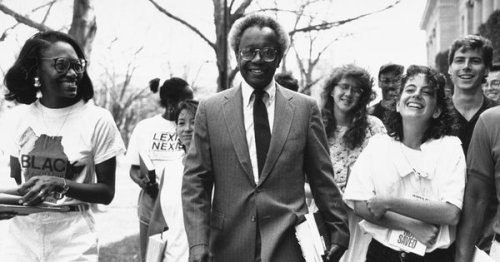
Derrick Bell walking with a group of Harvard law students after taking a voluntary unpaid leave of absence to protest the lack of tenured minority female professors. Credit: Steve Liss/Time Life Pictures, via Getty Images.
1987 – Latino Students Organize to Create a Law Journal Focused on Scholarship Pertinent to Latinos.
5/11/1988 – BLSA Holds a Study Vigil to Protest Minority and Female Faculty Hiring. Robert Wilkins, BLSA president (and United States Court of Appeals judge), said that “[t]he faculty representatives did not appear to have any specific plans, projects, visions or goals to solve the faculty hiring problem. In fact, Vorenberg and others refused to admit that the problem [was] serious, or set any goals for increasing minority hiring, instead he praised Harvard Law School’s ‘great progress’ and assured us that they were ‘committed’ to solving the problem.”
3/22/1989 – La Alianza Stages Protest at Faculty Meeting. La Alizanza’s co-chair explained, “It’s a matter of trying to highlight the fact that there are no Hispanics in the faculty. The message is, ‘It’s okay for Latinos to be students, but they are not good enough to be professors.'”
4/6/1989 – Nationwide Class Strike. The first nationwide class strike day on April 6, 1989, organized by University of California at Berkeley’s Law School in order to encourage law schools to increase diversity in the faculty and student body, was implemented at HLS by a precursor to CCR–a group called the Student Coalition for a Diverse Faculty. This coalition was made up of La Alianza, the American Indian Law Students Association, the Asian American Law Students Association, the Black Law Students Association, the Committee on Gay and Lesbian Issues, and the Women’s Law Association.
1989 – BLSA Demands. BLSA issued a list of demands to Dean Vorenberg where they asked the faculty to hire a Black female tenured or tenure track professor, increase of twenty tenured faculty members of diverse backgrounds within four years and wanted student participation on the appointments and search committees, and the creation of a fellowship program geared for minority students who are interested in a career in law school teaching.
1989 – Latino Students Crank Up Organizing Around Faculty Diversity.
9/1989 – Coalition for Civil Rights (CCR) Formed. CCR was made up of a number of student organizations including the Black Law Students Association, La Alianza (the Latino Students Association), the Asian American Law Students Association, the Native American Law Student Association, the Women’s Law Association, the Committee on Gay and Lesbian Legal Issues, the Disabled Law Students’ Association, and the National Lawyers Guild.
1990 – Derrick Bell takes leave of absence to demand minority female faculty. Derrick Bell, supporting student protesters demanding more minority female faculty, takes an unpaid leave of absence from Harvard Law School to demand black female faculty.
4/5/1990 – Second nationwide class strike day; CCR’s first public event. CCR’s first public event was organized around the second nationwide class strike day, which was in the spring semester following the successful public interest advising protests. On Thursday, April 5, 1990, around 300 students attended a CCR rally at HLS and then marched to Dean Clark’s Office. Dean Clark refused to meet with the students. CCR subsequently organized overnight sit-ins at the Dean’s office on that day and the following Monday–around eighty students participated in each sit-in. The students demanded that a woman of color be hired by the fall and that faculty members suspend a policy that delayed the permanent hiring of visiting professors for at least one year after they finish teaching.
4/13/1990 – Dean Clark meets with students. Dean Clark met with law students at a forum to discuss minority faculty hiring. The students, once again, demanded quicker tenure considerations for visiting minority professors. Dean Clark responded, “I’m not inclined to wa[i]ve the year-away policy [for evaluating the tenure of visiting professors] under any circumstances, but we’ll see.” Clark maintained that the policy was necessary to prevent undue pressure on visiting professors while they are at HLS. The subsequent inconsistent application of the year-away policy would be one of main issues that led the protests to escalate.
11/20/1990 – Students sue Harvard Law School. CCR sued Harvard University pro se, claiming that HLS was engaging in discriminatory faculty hiring practices. CCR members used their legal training to apply pressure to HLS. Instead of hiring a lawyer, eleven CCR members, who were all HLS students, represented themselves in court. They filed a lawsuit against Harvard University in Massachusetts Superior Court at the Middlesex County Courthouse in Cambridge, Massachusetts.
3/3/1991 – Students Argue Lawsuit Standing Issue in Front of the Supreme Judicial Court. Over 150 Harvard Law students attend.
4/4/1991 – Third nationwide class strike. Over 300 students boycotted and some professors canceled class. CCR organized a morning teach-in, a rally at 12:00 noon, and an afternoon march to outgoing Harvard President Derek C. Bok’s office.
4/6/1992 – Griswold 9 sit-in. Nine CCR members, protesting the lack of any women of color and members of other historically underrepresented groups on the permanent faculty, staged a peaceful sit-in in the corridor outside Dean Robert C. Clark’s office. Julie Su and others, wearing paper masks that portrayed the visage of Dean Clark, staged a peaceful sit-in in the corridor outside the Dean’s office, which was located in Griswold Hall. They began the sit-in around noon and remained for twenty-four hours. The Griswold 9 were composed of members and leaders of various affinity groups at HLS. They were from different HLS class years and undergraduate institutions.
4/7/1992 – End of sit-in. Seventy-five students had joined the supporters outside, informing the national media of the protest.
5/4/1992 – Aftermath. First time Harvard Law School students were publicly tried by their school’s Administrative Board for conducting an overnight sit-in at the Dean’s office (the Griswold 9 incident).
1995 – CCR Calls Out Administration in the Record. CCR leaders wrote in the record “The Student Task Force on diversity, which published a long article in the Record two weeks ago, has no substantive role in the appointments process. This task force is another in a line of committees set up by the Administration to appease students and make us believe that we have some say in the quality of our education.”
1995 – Latino Law Review Finally Allowed to Use the Harvard Name. After 7 years of lobbying, the Law School allows the journal to use the Harvard name, but still makes no financial commitment.
1999 – Start of Living Wage Campaign. Students in Harvard’s Progressive Student Labor Movement plan a living wage campaign, designed to bring the gains of Cambridge’s living wage ordinance – at the time still pending approval – to the city’s largest employer.
View full interactive timeline of Living Wage Campaign here.
7/1998 – Lani Guinier Becomes First Women of Color Appointed to a Tenured Professorship.
2/1999 – Living Wage Campaign’s Letter to Harvard President and Provost. The Living Wage Campaign sends a letter to Harvard President Neil Rudenstine and Provost Harvey Fineberg requesting a meeting to discuss the idea of implementing a living wage policy at Harvard. Rudenstine and Fineberg do not respond, but instead instruct Director of Labor Relations Kim Roberts to send the Campaign a letter; she does not respond to the request for a meeting, but simply writes that Harvard’s wages and benefits are fair. The Harvard Living Wage Campaign holds its first rally; marchers go to Massachusetts Hall in hopes of setting up a meeting with Harvard University President Neil Rudenstine or Provost Harvey Fineberg. The University responds by barring the doors of Massachusetts Hall, and the Living Wage Campaign leaves a note.
3/1999 – Rally for Justice. The Living Wage Campaign works with Harvard Students Against Sweatshops and the Harvard Coalition Against Sexual Violence to organize the 400-person Rally For Justice.

Rally for Justice

Harvard Coalition Against Sexual Violence protest
3/1999 – President Rudenstine appoints task force. After the Cambridge City Council passes a resolution urging Harvard to adopt a living wage, as recommended by the Harvard Living Wage Campaign, President Rudenstine announces that he and Provost Harvey Fineberg will “appoint a special task force of faculty to review the living wage.”
4/1999 – Harvard University Security, Parking, Museum Guards Union and Living Wage Campaign rally. They demand fair contracts with a living wage. The guards had been working for over four years without a contract.
4/19/1999 – The Miners’ Canary Lectures. Lani Guinier and Gerald Torres give the Nathan I. Huggins Lectures at Harvard University, advocating that critiques of people of color should “alert us to the presence of more systemic problems . . . [and that] we must look at those critiques as a reflection of what is not working in our institutions.”
5/1999 – 115 Harvard faculty members endorse the Living Wage Campaign.
7/1999 – Alumni Pledge. The Living Wage Campaign organizes over 100 alumni and alumnae to pledge never to give money to Harvard until the university implements a living wage.
7/1999 – Harvard admits that it has committed systematic abuses of the casual payroll. Harvard admitted to keeping hundreds of workers classified as “casual” even though they worked for as many as ten years and, in some cases, 40 hours a week or more.
4/2000 – Living Wage Office Occupation. President Rudenstine refuses to meet with the Living Wage Campaign. Thirty campaign members occupy the Harvard College admissions office for six hours to distribute information about poverty on campus to the hundreds of admitted students.
11/2000 – Harvard Provost and President say living wage a closed issue. Provost Fineberg and President Rudenstine say that they see the living wage a closed issue, and will consider no future policy changes. They argue that the report of the Ad Hoc Committee on Employment Policies (comprised of administrators and faculty appointed by Rudenstine and one staff member) reflected the views of the entire Harvard community.
12/2000 – Interview public displays. The Living Wage Campaign puts a display in Harvard’s Science Center; the display consists of transcriptions of interviews with Harvard workers. The administration demands that it be removed the next day or it will be torn down. Twenty-five PSLM members and union representatives converge on the Science Center to argue that the display be kept up; the administration retracts its threat to tear down the display.
4/2001 – Living Wage Campaign meets with President Rudenstine. Rudenstine defends the Ad Hoc Committee’s thirteen-month investigation as “thorough.” Rudenstine concludes that it would be too “time consuming” to initiate any further research into a living wage policy.
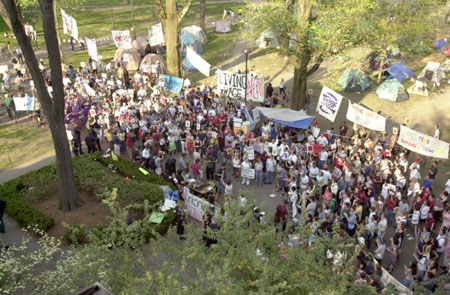
May 2, 2001: Living Wage Rally outside of Mass Hall. Participants marched from Central Square. Rose Lincoln Staff Photo/Harvard U. News Office digital image
4/2001 – 5/2001 – Occupation. Nearly fifty students occupy Massachusetts Hall, which houses the office of the President and other university administrators, in protest of Harvard’s poverty wages and the administration’s refusal to consider the living wage issue any further. During the three-week sit-in, the campaign organizes daily pickets and rallies drawing up to 2000 people, collects 400 faculty signatures in support of a living wage, and gains the endorsement of four U.S. Senators. Over a hundred Harvard alumni/ae stage a mock sit-in at the Harvard Club of New York in solidarity with the protestors in Cambridge.
5/2001 – Creation of Katz Committee. After three weeks, 25 students leave Mass Hall with an agreement from the university to create a committee with faculty, administrators, students, and workers, charged with studying Harvard’s labor policies and recommending changes; to announce a moratorium on outsourcing until the committee’s deliberations are complete; and to renegotiate a contract with the janitors’ union in early 2002. Undergraduates who participated in the sit-in are put on disciplinary probation. Students at the law school are given official reprimands. Dining hall workers settle a contract with Harvard, raising the pay of all but a dozen workers to above the Cambridge living wage level.
8/2001 – New Harvard President, Lawrence Summers. Summers defends outsourcing as necessary to maintain “efficiency” on campus, and refuses to sign a public statement against worker intimidation, and refuses to recognize the Sweatshop Code of Conduct previously agreed to by PSLM and the University General Counsel, claiming it was only a draft.
11/2001 – Thousand-people march. In the first demonstration organized by Harvard janitors in decades, nearly a thousand people from the Harvard community march through the streets of Harvard Square to demand fair wages and benefits for Harvard custodians.
12/2001 – Katz Commitee Final Report calls for immediate wage increases. The Committee calls for immediate wage increases for service workers (via the renegotiation of contracts with campus unions), equal pay for directly-hired and outsourced workers, more affordable benefits, a “fair bargaining clause.”
1/2002 – Over a hundred faculty sign a public statement urging President Summers to go beyond the Katz Committee’s recommendations and implement a permanent living wage standard.
1/2002 – President Summers announces the adoption of many of the Katz Committee’s proposals. These include a one-time wage boost and wage and benefit parity between directly-hired and subcontracted workers. However, Summers rejects the Committee’s “fair bargaining clause,” makes no commitment to affordable benefits.
4/2002 – Promises still not being implemented. Two months after Harvard adopted many of the HCECP recommendations the promises were not being implemented: hundreds of outsourced janitors were not receiving the pay increases given to directly-hired janitors, the university had done nothing to make health benefits more affordable, and had taken no steps to end worker harassment. Many janitors continued to face repeated intimidation and illegal unishment for their union activity. Some had been transferred to new work locations, many had been harrassed by their bosses, and several were suspended without reason.
5/2002 – Contract settlement for Harvard security guards. In the face of growing campus support for Harvard guards, the university settles a contract with the guards’ union.
6/2002 – Contract for dining hall workers. The union representing dining hall workers signs a contract with the university. Starting wages for many workers in the union is now $10.85 per hour — a significant improvement from $9 under their previous contract, but still less than the Cambridge Living Wage level, at $11.11.
It is rumored that the gap in advocacy for systemic change in the early 2000’s resulted from Dean Clark asking Admissions to reject students with activism backgrounds.
3/7/2013 – Shatter the Ceiling’s first meeting with Dean Minow. Newly-formed Shatter the Ceiling met with Dean Minow to discuss the performance gap and possible solutions. They asked for more than one female professor for every 1L section to combat stereotype threat, and for a Harvard Business-School-style Gender Task Force.


3/13/2013 – Shatter the Ceiling screens its documentary at Kick-Off Meeting. 8-10 men and women spoke about their gendered experiences at the law school. Over 200 students came.
3/24/2014 – Request for gender town hall. Shatter the Ceiling met with Dean Minow to ask her to appear in person for a town hall meeting addressing gender issues. She refused. Shatter requested more data around success at HLS and transparency, as well as increased female professors. Dean Minow just told them to have students write her directly if they had concerns about the lack of female faculty.
4/3/2014 – SFI: A Conversation about 1L. Invited students to share their 1L/HLS experiences.
4/4/2014 – Pre SFI Meeting with Minow. Domonique Worship, former Minow Research Assistant, meets with Minow to share SFI concerns.
4/22/2014 – Meeting with Dean Minow before officially becoming SFI. Discussed student and faculty task force for diversity issues, financial aid, orientation, curricular reform, diversity office, the school’s overall attempts to welcome students of color. Professors Sullivan and Ogletree were present.
7/31/2014 – Student-faculty Task Force Emails. Students follow up on Dean Minow’s agreement to create a student-faculty task force to address diversity issues. Response was that discussions were taking place.
9/3/2014 – Shatter meeting with Minow about the performance gap, asking for more data on the gender and racial performance gap, again. Dean Minow refused to release that data, again.
11/1/2014 – SFI meeting with Deans Minow, Cosgrove, Soban. Discussed follow up to student and faculty task force. Was told about efforts made over the summer by Dean’s Office.
11/11/2014 – SFI Launches Socratic Shortcomings. Public space created for people to share concerns and experiences at HLS.
11/17/2014 – Sexual assault/climate meeting with Dean Minow. SASH/WLA members met with Dean Minow to ask about better sexual assault prevention programming and gender equality programs at the law school. They asked for a Climate Committee with students and faculty for more direct student input into the new sexual assault procedures and climate. Dean Minow said she was confused about what the problem was, and spoke about how the school was much better than when she attended, and that women needed to be more assertive participators.
12/1/2014 –Students stage ‘Hands up’ Ferguson protest. Law students and staff chanted “Hands up, don’t shoot” and held up their hands, remembering Ferguson teenager Michael Brown, who had his hands up when he was shot by a police officer.
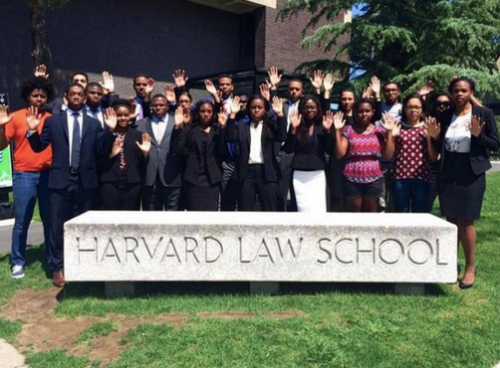
12/7/2014 – Coalition of Eight Affinity Groups and Fifteen Ally Student Groups Asked for Support and Campus Discussion of Racial Tensions after Black Lives Matter. Among other asks, the Coalition stated, “Harvard Law School can and must do more to facilitate conversations about injustice and inequality on this campus and beyond it. We ask that these conversations take place in our classrooms, in school sanctioned forums, and in safe spaces created by the administration.”
12/8/2014 – Dean Minow and Dean Cosgrove respond without addressing demands concretely.
12/8/2014 – Affinity Group Coalition responds demanding a more concrete response. Student asks include culturally competent counseling and that Dean Minow “meet the example set by our peer institutions by sending an email that directly addresses our concerns… National events call for an official Law School response. This is an important movement in the history of race relations in the United States.” The students included examples of emails Dean Minow sent to the student body following other national tragedies, including the Passing of Nelson Mandela, the Sandy Hook Shooting, and Hurricane Sandy.

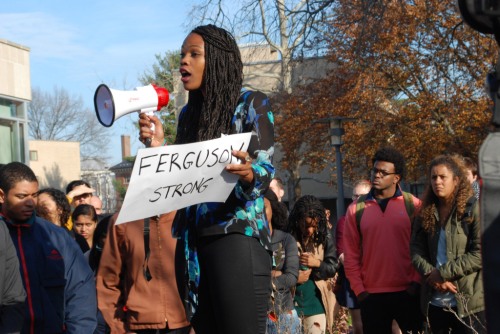
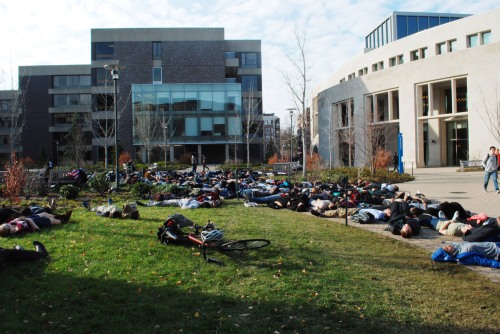 12/8/2014 – Community Meeting. After additional pressure, Dean Minow agrees to hold a community meeting; speaks up on the issue and Dean of Students Office makes existing resources more public and brings additional support in.
12/8/2014 – Community Meeting. After additional pressure, Dean Minow agrees to hold a community meeting; speaks up on the issue and Dean of Students Office makes existing resources more public and brings additional support in.
12/10/2014 – Community Meeting on Race on Campus and Black Lives Matter. Individual students, faculty, and staff share their personal stories about racism on campus and the marginalization of students of color. Several students from SFI explicitly mention the importance of policy changes within the school, including some of the specific demands later demanded by Reclaim Harvard Law in 2015.
12/17/2014 – SASH/WLA makes objections to the draft procedures. SASH and the WLA asked for more student input in the Title IX Committee as the procedures would be refined in coming months. Instead of appeals basis of “gross procedural error,” the new draft included “excessive or insufficient remedy,” instead, an extremely broad basis of appeal from the much-negotiated-over adjudication process. This put broad appeal power in the faculty’s hands.
12/22/2014 – Reply regarding student input to new Title IX procedures. The SASH/WLA were told in an email that there would be student liaisons to the Title IX Committee to help it refine procedures over the following months, and that students could have input in the selection of adjudicators.
1/9/2015 – Meeting with Dean Minow and HFAC/SFI leaders.
2/11/2015 – Law School Matters – SFI hosts “Law School Matters: Reassessing Legal Education Post-Ferguson” conference. This conferenced addressed race and legal curriculum, brought six professors to model contextualized teaching of 1L cases, the history of race-based student activism at HLS and the importance of critical race theory in legal education. Keynote speech given by Kimberle Crenshaw and Gary Peller — two HLS alum and Critical Race Theorist law professors — followed by a panel including Dean Minow.
2/2015 – BLSA asks Dean Minow for mentorship program and orientation changes. Black Law Students Association leaders ask Dean Minow to 1) start a faculty mentorship program for students of color; 2) Have a session at orientation related to diversity and inclusion; and 3) provide diversity and inclusion training for all professors. On the mentorship program, Dean Minow referred them to OCS to see it it would help start a small opt-in version; no diversity & inclusion training was provided at orientation to students, and nor was one provided for faculty.
2/24/2015 – SFI/Shatter evaluation changes proposal. Shatter the Ceiling and Students for Inclusion propose language changes to course evaluations following discussions with Dean Cosgrove: 1) Diversity issues related to course content were well addressed; 2) Course helped me understand how to apply my learning to real problems and contexts; 3) I felt that this professor cared about my success in class; 4) I felt comfortable approaching this professor with questions, concerns, and ideas. Numbers 1 and 2 are language taken directly from Harvard Graduate School of Education course evaluation. Dean Cosgrove said she didn’t think it would be a problem to add questions, especially the ones already used at another Harvard school, in time for the Fall evaluations.
3/13/2015 – Shatter reaches out to Registrar for latin honors gender breakdown. Asked for the gender breakdown (no names) of the 2014 latin honors recipients. The Registrat refused to give it to them, saying that it was confidential.
3/24/2015 – Shatter publishes the annual numbers and article “Gender Disparities in Law School Participation Remain.”
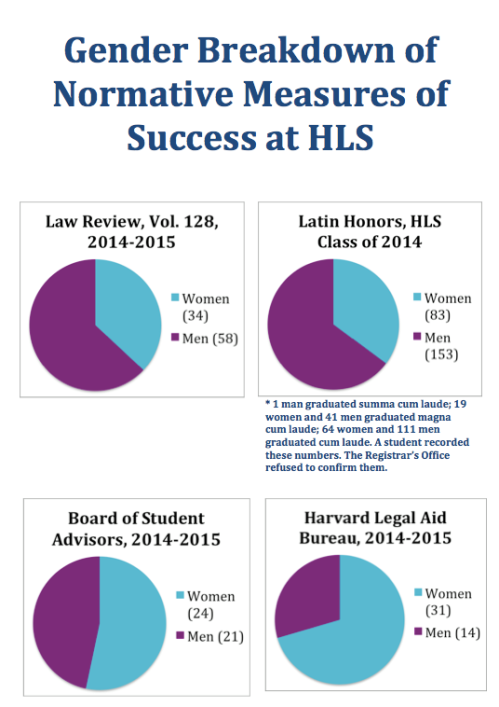
3/27/2015 – Shatter the Ceiling and SFI Faculty Awards Ceremony. Shatter the Ceiling and SFI host faculty awards ceremony with awards based on feedback from a student survey rating curriculum, use of context, mentorship, and teaching skills. The award for Mentorship went to Jon Hanson; Gender Equality in the Classroom to Catharine MacKinnon; Racial Equality in the Classroom to Jennifer Chacón; Integrating Feminist and Critical Race Scholarship into the Legal Curriculum to Elizabeth Emens, and Integrating Social Justice into the Legal Curriculum to Lani Guinier. Only two of the five professors students ranked highest in these categories were tenured HLS professors; the other three were visiting professors.
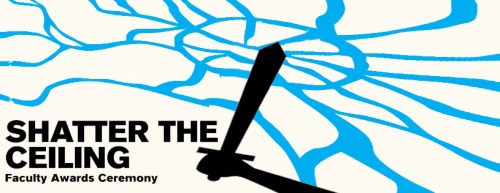
4/14/2015 – Affinity Group Coalition meeting with Dean Cosgrove. Discussed evaluations (Dean Cosgrove said she ultimately thought it was Dean Minow’s decision); orientation (Dean Cosgrove said Dean Minow, Jeff McNaught, and she were overseeing orientation and would loop back to us for input — they never did); more student input in faculty decision-making, with a suggestion being that Thursday faculty meetings be open to students (Dean Cosgrove shared our frustration about faculty dominance and said administrators aren’t allowed to go to faculty meetings either); a pot of money in DOS for security for controversial speakers who groups invite, rather than groups bearing sometimes unforeseen security costs (Dean Cosgrove said the Finance Office wanted to wait for next dean to weigh in); and better communication to students about what their rights are in a crisis, following the administration strong arming the WLA (Dean Cosgrove said the orgs training would include a note that the Communications Office serves the school, not the groups).
4/27/2015 – Affinity Group Coalition meeting with Dean Cosgrove. Topics discussed included Title IX (leaders saying slides over the summer were not enough, and there would need to be a conversation, or at least long statement, when students arrived at HLS); PSW including a social justice component (Dean Cosgrove said that was up to the professors who run it, but she didn’t think big changes were likely, just individuals like Professor Rakoff and Professor Wilkins trying things like body camera problems); and DOS website changes so that it would include a gender neutral bathroom map, possibly SFI’s justice tour map, faculty committees and the faculty members on those committees, and a list of the visitng professors for the last ten years so that students could see if any were willing to come back. Dean Cosgrove said yes to all of these website changes, and that it would be a summer goal handled by Jeff McNaught.
4/2015 – WLA ask for independent crisis management for groups in the news. WLA leaders met with Dean Minow to ask for independent crisis management for student organizations in the media, to ensure that the Harvard Law Communications Department never strong-armed a group into doing what the Office thought best for the school, but not best for that student group, again.
5/2015 – Evaluation changes delayed. Dean Cosgrove told Shatter/SFI to send evaluation proposal to Jeff McNaught to address over the summer. Jeff McNaught expressed at the end of the summer that he might as well wait for Dean Sells’ input. The project was presented to Dean Sells by affinity groups on September 14th.
10/23/2015 – Royall Must Fall Kickoff Rally. 25+ students gathered in Kumble Plaza to show solidarity with South African student protesters and call on students, staff, faculty, and alumni to decolonize Harvard Law School, with one first step as removing the Royall family crest from the Law School’s shield.
10/26/2015 – Student Government’s newly-formed Diversity and Inclusion Committee requests meeting with Dean Minow.
11/2/2015 – Dean Sells says student evaluation changes unlikely. Dean Sells said she talked with Dean Minow and Dean Claypoole about evaluation language changes and doesn’t know if we’ll get any language changes, because, among other reasons, they have to make sure the faculty are comfortable.
11/4/2015 – Student Government’s newly-formed Diversity and Inclusion Committee follows up on its request for a meeting with Dean Minow.
11/8/2015 – The WLA published letter about sexual assault. WLA Title IX statement published a letter (written last year) with requests regarding sexual assault policy: (1) guarantee an effective advocate free of charge for both parties during Title IX proceedings; (2) provide neutral investigators housed outside the Title IX office to maximize impartiality; (3) limit the role of faculty unless a student specifically requests the advice or counsel of a particular faculty member throughout the proceeding (“Faculty expertise is generally not in sexual harassment, and faculty members are typically removed from the social environments surrounding these incidents”); and (4) provide increased clarity and transparency, including clarifying who qualifies as a mandatory reporter and what constitutes “unwelcome conduct” under the new policy.
11/9/2015 – Student Government’s newly-formed Diversity and Inclusion Committee follows up on its request for a meeting with Dean Minow a second time.
11/18/2015 – Royall Must Fall publishes open letter demanding the shield change.

11/19/2015 – Someone Places Tape Over Black Faculty Portraits.
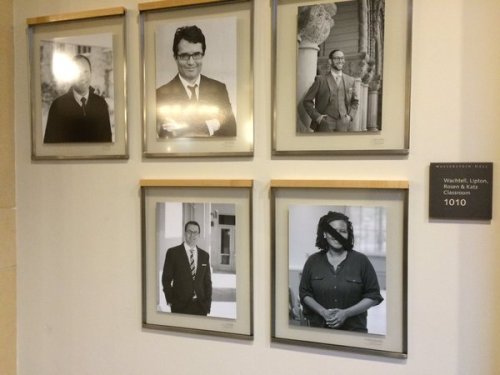
11/19/2015 – Emergency Community Meeting. Individual students and staff mention many of the demands and how they are good ideas for institutional change.
11/20/2015 – Diversity and Inclusion Committee of Student Government meets with Dean Minow and Dean Sells. Committee asks for 1) a Diversity and Inclusion Office; 2) changes to orientation; 3) for the administration to publicize the names of the faculty committees and who chairs them; 4) more student involvement in hiring; 5) changes to the student evaluations. Regarding the Diversity and Inclusion Office, Dean Minow responds that Dea Sells was hired to deal with those issues in DOS, and when asked about faculty and staff of color are told that she would only talk about student issues with us. She was willing to change orientation, which has already been in starting the changing process this year. Dean Minow said she would think about publishing the names of the committees and there chairs, and that she would ask Dean Claypoole.
11/23/2015 – Dean Minow meets with Royall Must Fall – Dean Minow proposed committee to revise crest but did not give details. Said she would announce at next Community Meeting.

11/24/2015 – Dean Sells meets with affinity group leaders. Meeting scheduled to discuss and plan ideas for November 30th Community Meeting. A plan was made for student leaders to divvy up a certain portion of the time to discuss problems in the community. Students then did not hear from DOS or Dean Minow again, and Dean Minow ultimately ignored that plan.
11/30/2015 – Community Meeting. Dean Minow speaks for 30 minutes, followed by representatives from the administration — with two minutes left (and a strictly-enforced end time), a student says he was disappointed that there was no more time for student voices; Dean Minow snaps, “does anyone have an actual comment.”
11/30/2015 – Affinity group leaders and other interested students meet. They discuss systemic issues at HLS and common requests of the administration.
12/1/2015 – Students from Justice Lab, SFI, affinity groups, and other interested students meet to form Reclaim Harvard Law and discuss demands.
12/2/2015 – Student Government meeting. Growing coalition of more than a hundred students present the demands at open Student Government meeting, called for that purpose. Many more students express interest in joining the conversation and join the coalition.
12/4/2015 – Community Meeting. Reclaim Harvard Law presents united demands and requests a response from Dean Minow by 9AM Monday, December 7.
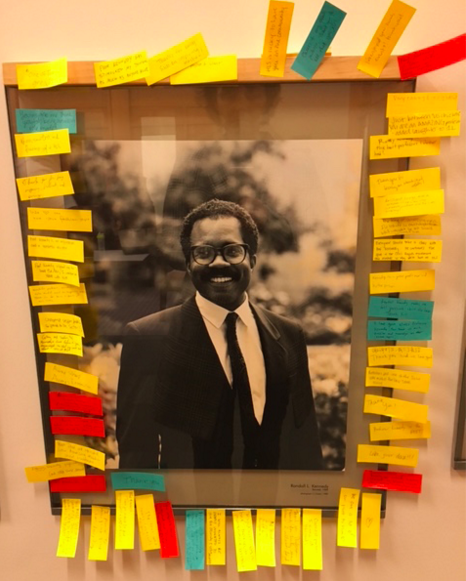
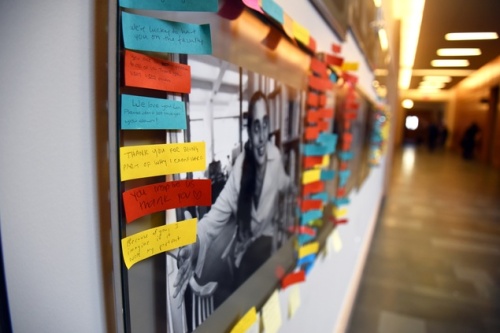 Students decorate portraits of black faculty with statements of love, appreciation, and solidarity
Students decorate portraits of black faculty with statements of love, appreciation, and solidarity
View interactive version of timeline here.
Sources
Kimberlé Williams Crenshaw, Twenty Years of Critical Race Theory: Looking Back to Move Forward, 43 Conn. L. Rev. 1253 (2011)
Luz E. Herrera, Challenging A Tradtion of Exclusion: The History of an Unheard Story at Harvard Law School, 5 Harv. Latino L. Rev. 51 (2002)
Philip Lee, The Griswold 9 and Student Activism for Faculty Diversity at Harvard Law School in the Early 1990s, 27 Harv. J. Racial & Ethnic Just. 49 (2011).
The Harvard Living Wage Campaign. “A Brief History of the Living Wage Debate at Harvard.” http://www.hcs.harvard.edu/pslm/livingwage/timeline.html.
Time of Troubles. The Crimson (June 9, 1983).